A Tale of 2 Triumphs
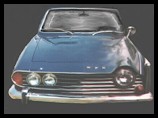
(Well actually four, but who is counting?)
Welcome to my web site. My name is David Herr and my Triumph infatuation began over
15 years ago. Actually, my love of British cars goes back much further to my
early teen years when I first started
noticing that not everyone drove the same boring cars that my parents owned. Once I
was in my mid teens, a subscription to Car & Driver opened up my world to the sports car.
My first actual car (after a home made go-cart), was a 1967 MGB, that I paid the amazing
price of only $300! Of course, the car 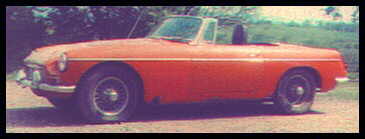 was actually worth less than $300, but what did I know? It was a
real sports car (but not a Triumph) and I owned it. This car taught me all about cars by
giving me "hands on " experience. By the end of the first year, I had experience
with almost every part on the car. But since my budget was tight (struggling college student), the
car eventually self-destructed during a high-speed race up a mountain verse an Alfa Romeo
Spider. I then learned not to ignore the oil pressure gauge. The car was sold for scrap
(there was not much metal left, but lots of Bondo) and my car owner ship switched to much
more mundane transportation. But since I drive over 40,000 miles per year, I get to
purchase a car every few years. As the years went by, I started getting less practical
cars and my commuter cars started becoming my weekend projects. A 280Z replaced my crashed
Honda Accord and a Civic Si replaced the 280Z. My wife jumped into the game too, with a
Fiat X/19 and a CRX SI. But one lesson I quickly learned was this; it is not fun to be
fixing/repairing your daily transportation on Sunday, so that you can go to work on
Monday. Two cars, one for work and the other for fun, was the answer! Plus, I longed for a
real sports car again. The Japanese cars were great as daily transportation, but I wanted
a car that I could take apart and restore. I also knew that the only way to have a
reliable British car was to take it apart and make sure everything was okay. I did not
have enough money to buy a car in top condition, plus this would take away some of the
fun. Thus, I needed to find a project car, British made and different from the normal MGBs
and other cars that you see. I knew of the various makes of British cars, but was
unfamiliar with the models. Triumph had some intriguing cars, and getting parts did not
seem to be a problem, so I started researching the Triumph car models. The first car that
I set my heart upon was a TR3. I had seen a few of these; the cut down doors and rugged
appearance attracted me. But it soon dawned on me that finding one of these cars, at an
affordable price, was not going to be possible. Thus, I started looking at the other
models. The TR6 had enormous appeal, but something inside of me wanted an older car. The
TR4-250 models were a mystery. I had never seen one on the road, only seen a few pictures
in the back of an old "Start Your Engines" catalog. Anyone remember that old
place? A great source for parts and advice prior to being purchased by Moss in the middle
80's. There were a few TR4 models for sale down in Washington, DC where I worked so I
decided to check them out. But prior to getting around to looking at these cars, I saw an
ad for a TR8. Now I have always wanted one of these cars (still do), and the price was
only $5,000, this being in 1989. I went down to look at the car. It was metallic blue with
the tan interior and looked to be in decent shape. I would have bought it on the spot, but
Lori was pregnant and borrowing $5,000 would not have been the smart move. I ignored the
temptation and moved on. One day, I was at the Amoco station of my boss's brother. Talking
with the mechanics, I mentioned that I was looking for an old Triumph to restore. One of
the mechanics said, " I have an old Triumph that I could sell you". It turned
out that he had a 1965 TR4A that was actually worth less than $300, but what did I know? It was a
real sports car (but not a Triumph) and I owned it. This car taught me all about cars by
giving me "hands on " experience. By the end of the first year, I had experience
with almost every part on the car. But since my budget was tight (struggling college student), the
car eventually self-destructed during a high-speed race up a mountain verse an Alfa Romeo
Spider. I then learned not to ignore the oil pressure gauge. The car was sold for scrap
(there was not much metal left, but lots of Bondo) and my car owner ship switched to much
more mundane transportation. But since I drive over 40,000 miles per year, I get to
purchase a car every few years. As the years went by, I started getting less practical
cars and my commuter cars started becoming my weekend projects. A 280Z replaced my crashed
Honda Accord and a Civic Si replaced the 280Z. My wife jumped into the game too, with a
Fiat X/19 and a CRX SI. But one lesson I quickly learned was this; it is not fun to be
fixing/repairing your daily transportation on Sunday, so that you can go to work on
Monday. Two cars, one for work and the other for fun, was the answer! Plus, I longed for a
real sports car again. The Japanese cars were great as daily transportation, but I wanted
a car that I could take apart and restore. I also knew that the only way to have a
reliable British car was to take it apart and make sure everything was okay. I did not
have enough money to buy a car in top condition, plus this would take away some of the
fun. Thus, I needed to find a project car, British made and different from the normal MGBs
and other cars that you see. I knew of the various makes of British cars, but was
unfamiliar with the models. Triumph had some intriguing cars, and getting parts did not
seem to be a problem, so I started researching the Triumph car models. The first car that
I set my heart upon was a TR3. I had seen a few of these; the cut down doors and rugged
appearance attracted me. But it soon dawned on me that finding one of these cars, at an
affordable price, was not going to be possible. Thus, I started looking at the other
models. The TR6 had enormous appeal, but something inside of me wanted an older car. The
TR4-250 models were a mystery. I had never seen one on the road, only seen a few pictures
in the back of an old "Start Your Engines" catalog. Anyone remember that old
place? A great source for parts and advice prior to being purchased by Moss in the middle
80's. There were a few TR4 models for sale down in Washington, DC where I worked so I
decided to check them out. But prior to getting around to looking at these cars, I saw an
ad for a TR8. Now I have always wanted one of these cars (still do), and the price was
only $5,000, this being in 1989. I went down to look at the car. It was metallic blue with
the tan interior and looked to be in decent shape. I would have bought it on the spot, but
Lori was pregnant and borrowing $5,000 would not have been the smart move. I ignored the
temptation and moved on. One day, I was at the Amoco station of my boss's brother. Talking
with the mechanics, I mentioned that I was looking for an old Triumph to restore. One of
the mechanics said, " I have an old Triumph that I could sell you". It turned
out that he had a 1965 TR4A that 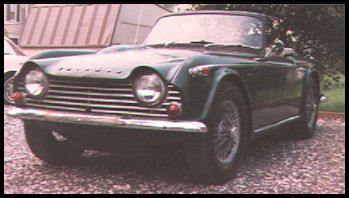 he had owned for many years and was ready to sell. It
was drivable, but rough and needed a lot of work. I went to see it and drove it around
his neighborhood. $1,000 was the asking price and I bought it on the spot. I knew nothing
about Triumphs and especially the TR4A model. I did not check any of the trouble spots
(like the frame for rot), etc… He gave me a load of catalogs from MOSS, TRF and
Victoria British to take home and we arranged to drive the car back to PA at the end of
the week. Thus began my Triumph ownership saga and I can confidently say that 15 years
later, I am familiar with every nut, bolt and washer in the car. The next page details the
long restoration that was finally completed in 1999. Back to the story. As the TR4A restoration labored on
and I realized that it would be a long time until I had convertible transportation again,
my devotion to the TR4A began to waiver. I started looking (actually I have never quit
looking), in car lots and backyards for another car. Having gotten the Triumph bug full
strength, I wanted a cheap Spitfire to drive as I restored the TR4A. The original idea was
to by a cheap (under $1,000) runner and use it with out spending any time and more
importantly $$$. I found a 1980 Spitfire for only $500. he had owned for many years and was ready to sell. It
was drivable, but rough and needed a lot of work. I went to see it and drove it around
his neighborhood. $1,000 was the asking price and I bought it on the spot. I knew nothing
about Triumphs and especially the TR4A model. I did not check any of the trouble spots
(like the frame for rot), etc… He gave me a load of catalogs from MOSS, TRF and
Victoria British to take home and we arranged to drive the car back to PA at the end of
the week. Thus began my Triumph ownership saga and I can confidently say that 15 years
later, I am familiar with every nut, bolt and washer in the car. The next page details the
long restoration that was finally completed in 1999. Back to the story. As the TR4A restoration labored on
and I realized that it would be a long time until I had convertible transportation again,
my devotion to the TR4A began to waiver. I started looking (actually I have never quit
looking), in car lots and backyards for another car. Having gotten the Triumph bug full
strength, I wanted a cheap Spitfire to drive as I restored the TR4A. The original idea was
to by a cheap (under $1,000) runner and use it with out spending any time and more
importantly $$$. I found a 1980 Spitfire for only $500.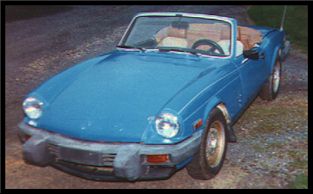 Someone had cut the dash out with wire cutters, but it
was not rusty and would need only minor work to make right. I bought it and soon decided
that I would like to have it ready for the TRF Summer Party in 1991. This being Memorial
Day weekend, 8 weeks was plenty of time. I then decided that the car needed painted, and I
could paint it myself and still make the deadline. 30 days later, we sprayed the car the
original Pageant blue. I bought a complete dashboard and removed it from the parts car in
the same manner that the original dashboard had been removed. This gave me the rest of the
wiring harness to splice to my cut harness to hook up all the under dash electric's.
Unfortunately, I did not make the deadline for the TRF Summer Party, but we had a good
time and met a lot of good TR4 owning friends. As often happens when you do a project such
as this (readers beware), I spent the rest of the fall and winter and restored the
Spitfire to a very respectable driver. I spent all my TR4 budget money on the car and bought new
interior, dash wood, convertible top, electric ignition, Weber carb., header,
Monza
exhaust, new suspension parts, etc…Still, I had less than $2000 in the car. Spitfires
are great fun on a limited budget. The car Someone had cut the dash out with wire cutters, but it
was not rusty and would need only minor work to make right. I bought it and soon decided
that I would like to have it ready for the TRF Summer Party in 1991. This being Memorial
Day weekend, 8 weeks was plenty of time. I then decided that the car needed painted, and I
could paint it myself and still make the deadline. 30 days later, we sprayed the car the
original Pageant blue. I bought a complete dashboard and removed it from the parts car in
the same manner that the original dashboard had been removed. This gave me the rest of the
wiring harness to splice to my cut harness to hook up all the under dash electric's.
Unfortunately, I did not make the deadline for the TRF Summer Party, but we had a good
time and met a lot of good TR4 owning friends. As often happens when you do a project such
as this (readers beware), I spent the rest of the fall and winter and restored the
Spitfire to a very respectable driver. I spent all my TR4 budget money on the car and bought new
interior, dash wood, convertible top, electric ignition, Weber carb., header,
Monza
exhaust, new suspension parts, etc…Still, I had less than $2000 in the car. Spitfires
are great fun on a limited budget. The car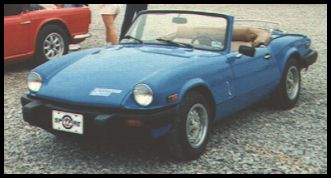 looked great and ran
fine. We spent the summer of 1992 using the Spitfire and running up over 8,000 miles on
the thing. Meanwhile my TR4A languished in the garage with only occasional work done on
it. The Spitfire was so much fun that my wife was also enjoying herself. At the Summer
Party that year, we saw our first Stag………. I had only read about this car,
and had never seen one before. Lori liked the back seat and mentioned that we should
replace the Spitfire with a Stag. I laughed and said that we could never find one in our
price range. The car we were looking at was for sale for $5,000. It was brown with a tan
interior and was in average shape. I enjoyed the Spitfire for the rest of the year, but in
the back of my mind I wanted a Stag….As the TR4A continued to rust in the garage, I
started my search for a Stag. Remember this: If I had known the amount of money that I
would be able to spend on the Spitfire and Stag, the TR4A would have been done years ago.
But since I had dismantled the TR4A completely, it would be many hundreds of hours until
it could be completed. It was far easier to spend time and money on the other cars.
Remember this as words of wisdom to the restoration newcomer. This is why Hemmings Motor
News and now Ebay are filled with half finished restorations. Reading Hemmings showed me that a Stag was
going to be a difficult purchase. First of all, the price of a nice car was far past my
budget. Restored cars were in the $10,000-12,000 range and this was double what I could
stretch to afford. Second of all, I had begun to research the history of the
Stag and discovered
why the cars were so rare in the states: The engines were a major source of problems. This
explained why all the Stags in my price range had various Buick, Ford and other
non-standard engine combinations. The other problem was that since the cars were so rare,
it meant that they were located in Texas, New York or Florida. Finding a local car, with
an original engine in decent shape and in my price range, was indeed a tall order. I saw a
Stag advertised in the Washington Post for only $1,500. It was located in Baltimore, so I
looked at it on my way home from work one evening. It was dark blue, with light blue
interior and wire wheels. Very pretty from a distance, but very rough up close. Seeing the
car in a brighter color really showed off the lines and this is what really sold me on a
Stag. The car had the hard top and the interior was in excellent condition. The exterior
had been covered with a car cover and the entire car had surface rust from the
condensation. The engine was missing as the owner had decided to do an engine conversion
(it was at his brother's place in New York). The final straw was that the wire wheels had
rusted to the splined hubs and the brake rotors had rusted solid. The car could not even
be pushed. Not needing another long-term project in my garage, I quickly ran away from
this nightmare, but still wanted a Stag. The Carlisle Import Show was to be the source of
my next car. As I prepared for the annual Carlisle event, I brought the Spitfire title
"just in case". I took a friend along and we got there just as it began to rain
on Friday. One thing about Carlisle, you want to be there on Friday if you are purchasing
a car. If it is a good car, it will be gone by Sunday. After parking the Spitfire in the
show field, we entered the first row. By the time we had made it to the beginning of the
third row of vendors, I saw a dark blue Stag. looked great and ran
fine. We spent the summer of 1992 using the Spitfire and running up over 8,000 miles on
the thing. Meanwhile my TR4A languished in the garage with only occasional work done on
it. The Spitfire was so much fun that my wife was also enjoying herself. At the Summer
Party that year, we saw our first Stag………. I had only read about this car,
and had never seen one before. Lori liked the back seat and mentioned that we should
replace the Spitfire with a Stag. I laughed and said that we could never find one in our
price range. The car we were looking at was for sale for $5,000. It was brown with a tan
interior and was in average shape. I enjoyed the Spitfire for the rest of the year, but in
the back of my mind I wanted a Stag….As the TR4A continued to rust in the garage, I
started my search for a Stag. Remember this: If I had known the amount of money that I
would be able to spend on the Spitfire and Stag, the TR4A would have been done years ago.
But since I had dismantled the TR4A completely, it would be many hundreds of hours until
it could be completed. It was far easier to spend time and money on the other cars.
Remember this as words of wisdom to the restoration newcomer. This is why Hemmings Motor
News and now Ebay are filled with half finished restorations. Reading Hemmings showed me that a Stag was
going to be a difficult purchase. First of all, the price of a nice car was far past my
budget. Restored cars were in the $10,000-12,000 range and this was double what I could
stretch to afford. Second of all, I had begun to research the history of the
Stag and discovered
why the cars were so rare in the states: The engines were a major source of problems. This
explained why all the Stags in my price range had various Buick, Ford and other
non-standard engine combinations. The other problem was that since the cars were so rare,
it meant that they were located in Texas, New York or Florida. Finding a local car, with
an original engine in decent shape and in my price range, was indeed a tall order. I saw a
Stag advertised in the Washington Post for only $1,500. It was located in Baltimore, so I
looked at it on my way home from work one evening. It was dark blue, with light blue
interior and wire wheels. Very pretty from a distance, but very rough up close. Seeing the
car in a brighter color really showed off the lines and this is what really sold me on a
Stag. The car had the hard top and the interior was in excellent condition. The exterior
had been covered with a car cover and the entire car had surface rust from the
condensation. The engine was missing as the owner had decided to do an engine conversion
(it was at his brother's place in New York). The final straw was that the wire wheels had
rusted to the splined hubs and the brake rotors had rusted solid. The car could not even
be pushed. Not needing another long-term project in my garage, I quickly ran away from
this nightmare, but still wanted a Stag. The Carlisle Import Show was to be the source of
my next car. As I prepared for the annual Carlisle event, I brought the Spitfire title
"just in case". I took a friend along and we got there just as it began to rain
on Friday. One thing about Carlisle, you want to be there on Friday if you are purchasing
a car. If it is a good car, it will be gone by Sunday. After parking the Spitfire in the
show field, we entered the first row. By the time we had made it to the beginning of the
third row of vendors, I saw a dark blue Stag.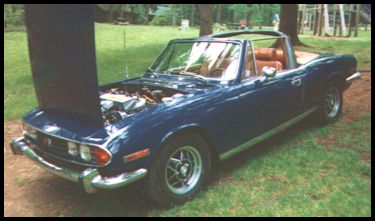 It had a tan interior, alloy wheels and
most importantly, it had the 4 speed manual overdrive transmission. It was in excellent
condition with no rust and decent cosmetics. The owner wanted $8,000 and it was probably
worth it. He started it up and it sounded good with no sign of overheating that the Stag
is infamous for. We thanked him and went down through the remaining rows of vendors. All I
could think about was that Stag. It had every option that I was looking for, it was a
local car and was not a car that needed a massive restoration. The only obstacle was the
price. However, the sign on the windshield did say that he would take $8,000 or an
interesting trade. Would he take the Spitfire in trade??? I quickly went back down to his
booth and discussed the details with him. He said to bring the Spitfire down to his booth
and he would consider a trade. As I quickly ran up to the show field, I could not believe
that I may actually be able to buy this car. When he saw the Spitfire, he thought for a
few seconds and said "give me the Spitfire and $4,000 and the Stag is yours". I
told him that he had a deal, and to give me a few hours to come up with the cash. I used
some creative means to acquire the necessary cash (promising myself that I could pay the
wife back in a few months) and closed the deal. As I drove the Stag home in the rain, I
wondered what I had just done and what the wife would say. Fortunately, the car was in
excellent condition and has been a joy to own and drive. I never intended to restore the
car, as the condition was fine for use as our family sports car. But just like the
Spitfire and the million-year TR4 restoration, no Triumph was safe from the restoration
disease. It had a tan interior, alloy wheels and
most importantly, it had the 4 speed manual overdrive transmission. It was in excellent
condition with no rust and decent cosmetics. The owner wanted $8,000 and it was probably
worth it. He started it up and it sounded good with no sign of overheating that the Stag
is infamous for. We thanked him and went down through the remaining rows of vendors. All I
could think about was that Stag. It had every option that I was looking for, it was a
local car and was not a car that needed a massive restoration. The only obstacle was the
price. However, the sign on the windshield did say that he would take $8,000 or an
interesting trade. Would he take the Spitfire in trade??? I quickly went back down to his
booth and discussed the details with him. He said to bring the Spitfire down to his booth
and he would consider a trade. As I quickly ran up to the show field, I could not believe
that I may actually be able to buy this car. When he saw the Spitfire, he thought for a
few seconds and said "give me the Spitfire and $4,000 and the Stag is yours". I
told him that he had a deal, and to give me a few hours to come up with the cash. I used
some creative means to acquire the necessary cash (promising myself that I could pay the
wife back in a few months) and closed the deal. As I drove the Stag home in the rain, I
wondered what I had just done and what the wife would say. Fortunately, the car was in
excellent condition and has been a joy to own and drive. I never intended to restore the
car, as the condition was fine for use as our family sports car. But just like the
Spitfire and the million-year TR4 restoration, no Triumph was safe from the restoration
disease.
|